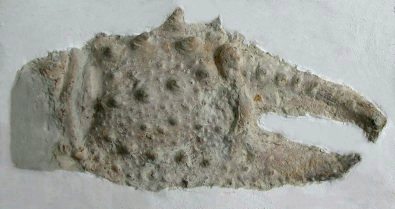 A
A |
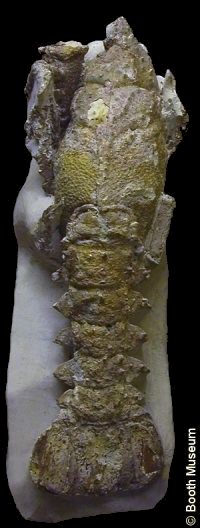 C
C |
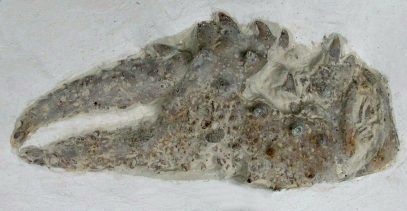 B
B |
|
Palaeastacus sussexensis (Mantell) |
This lobster is the most common of the Chalk crustaceans found within museum collections. The distinctive chelipeds are stout and robust, with a dense ornament of coarse thorns. Enoploclytia leachii is similar but has much longer fingers relative to its palm. Palaeastacus sussexensis occurs in the Grey Chalk and the Turonian.
 A
A |
 C
C |
 B
B |
1). (A, B) Isolated chelipeds, both x2, Grey Chalk, Randell Collection, (A) RR 0682, (B) RR 0683. (C) The holotype; a spectacular and rather unique three dimensional specimen, cephalothorax and abdomen with some incomplete appendages retained (x0.7), Grey Chalk, Clayton Tunnel, Sussex, from the Willett Collection, Booth Museum, BMB 007750, by kind permission of John Cooper).
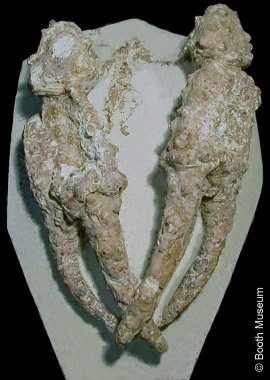 A A |
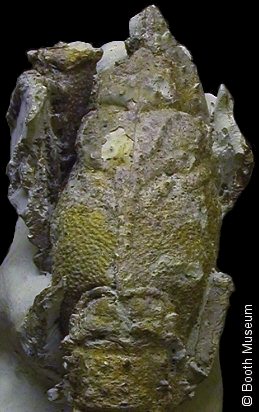 B B |
2). (A) A spectacular pair of chelipeds (x0.6), Grey Chalk, from the Potter Collection, Booth Museum, BMB 016990, by kind permission of John Cooper). (B) Cephalothorax of the holotype (x1.0).
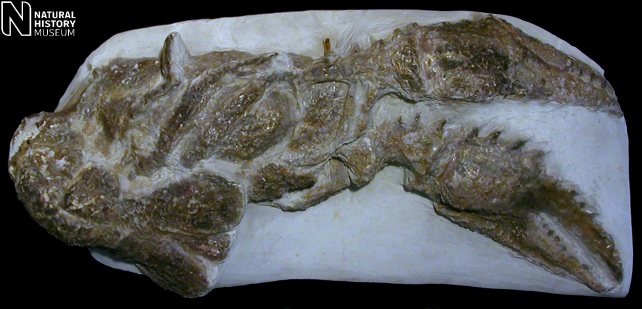
3). Right lateral (side) view of a remarkable specimen: a large individual, preserved whole, and having survived collection and preparation essentially intact (x0.7, Grey Chalk, Maidstone, Kent, unnumbered specimen in the collections of the British Museum (Natural History) London). Image © 2008 The Natural History Museum, by kind permission.

4). A remarkably complete individual, the pereiopods of which are very well preserved; view of right side, x0.9, ( (Grey Chalk, Glynde, Sussex, from the Willett Collection, Booth Museum, BMB 007756, by kind permission of John Cooper).
 A A |
|
|
5). Details of the above specimen; (A) left side, with the pereiopods lying across the carapace, x0.9, (B) underside, with the abdomen curled back over the last pereiopods, x1.7l
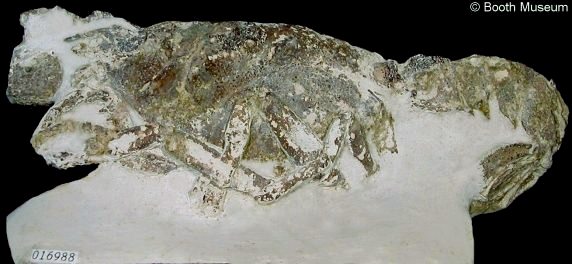 |
6). Another remarkable specimen, this individual having suffered a degree of compaction (x1.2, Grey Chalk, from the Potter Collection, Booth Museum, BMB 016988, by kind permission of John Cooper).
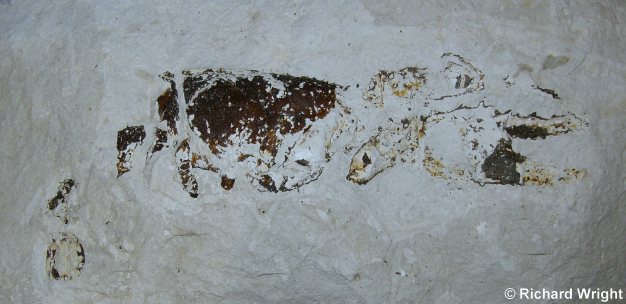
7). General view of a spectacular new specimen, awaiting preparation (x0.7 Grey Chalk, Bedfordshire, Richard Wright Collection). Image © 2010 Richard Wright.
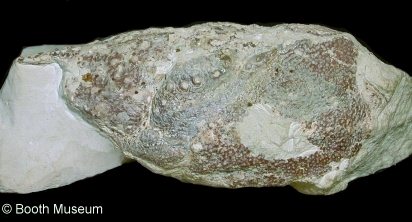 A A |
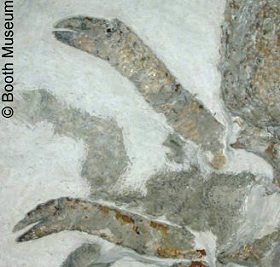 B
B |
8). (A) Isolated carapace (x1.5), Grey Chalk, Clayton, Sussex, from the Willett Collection, Booth Museum, BMB 07753, by kind permission of John Cooper). (B) Two exceptionally well preserved pereiopods (x1.5, Grey Chalk, Booth Museum, BMB 024316, by kind permission of John Cooper).
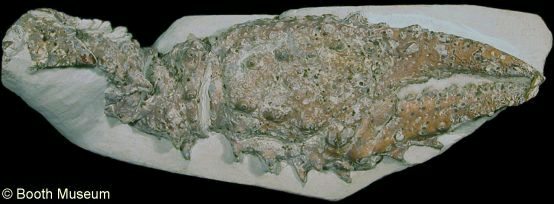 |
9). Well preserved cheliped from the Grey Chalk of Glynde, Sussex, Willet Collection, Booth Museum, BMB 07757, by kind permission of John Cooper (x1.3).
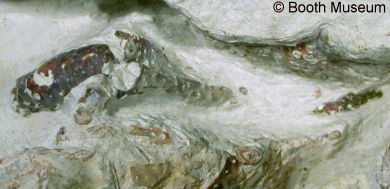 A A |
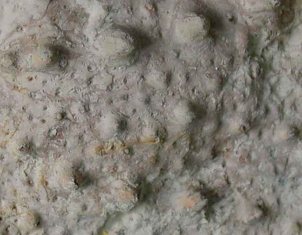 C C |
 B
B |
10). (A) The maxillipeds of a very well preserved individual from the Grey Chalk of Clayton, Sussex, Willet Collection, Booth Museum, BMB 07751, by kind permission of John Cooper (x3). (B, C) Details of the cheliped surface ornament; (B) Lateral view showing the thorn-like profile of the ornament; (C) Rows of thorns and pits on the palm. (A x3.5, B x4, both Grey Chalk, Randell Collection, RR 0682.
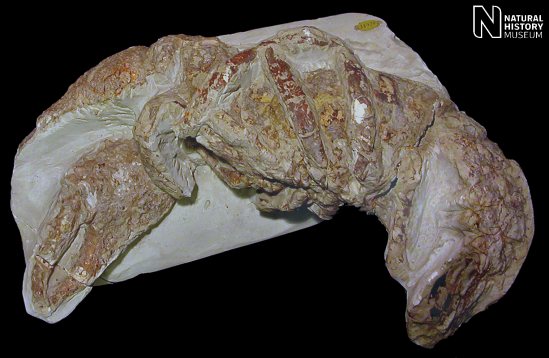
11). Left lateral view of a large individual and essentially complete specimen (x0.6, Grey Chalk, Burham, Kent, BMNH (British Museum (Natural History) London) 35275). Image © 2008 The Natural History Museum, by kind permission.

12). Dorsal view of a well preserved specimen retaining maxillipeds and pereiopods (x0.8, Grey Chalk, unnumbered specimen in the collections of the British Museum (Natural History) London). Image © 2008 The Natural History Museum, by kind permission.

13). Ventral (undersurface) view of a large and well preserved specimen which has suffered much damage subsequent to preparation - elements of the cheliped-bearing front appendages are well displayed (x0.6, Grey Chalk, British Museum (Natural History) London). Image © 2008 The Natural History Museum, by kind permission.
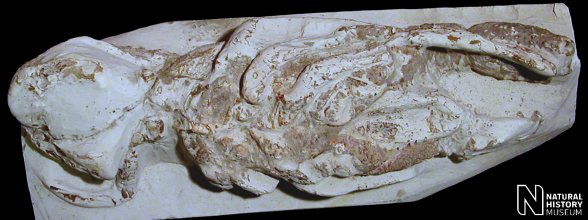
14). Ventral view of an individual preserved complete (x0.9, Grey Chalk, Halling, Kent, Bowerbank Collection, BMNH (British Museum (Natural History) London) 59737). Image © 2008 The Natural History Museum, by kind permission.

15). Right lateral view of near complete specimen (x1.1, Grey Chalk, Cowslip Pit, Guilford, Surrey, Capron Collection, BMNH (British Museum (Natural History) London) 59825). Image © 2008 The Natural History Museum, by kind permission.
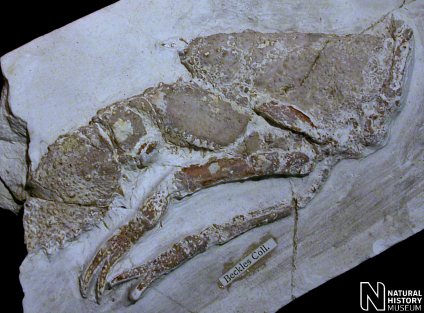 A A |
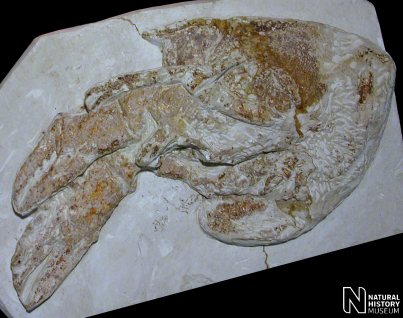 B
B |
16). Left lateral view of well preserved individuals: (A) x1.0, Grey Chalk, Kent, Beckles Collection, BMNH (British Museum (Natural History) London) In.27682); (B) x0.9, Grey Chalk, Cowslip Pit, Guilford, Surrey, Capron Collection, BMNH 59825). Images © 2008 The Natural History Museum, by kind permission.
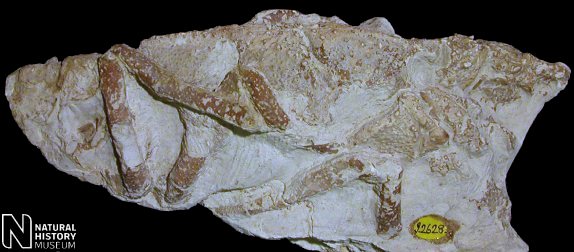
17). Right lateral view of a well preserved specimen (x0.9, Grey Chalk, Kent, Beckles Collection, BMNH (British Museum (Natural History) London) I.2628). Image © 2008 The Natural History Museum, by kind permission.

18). Right lateral view of the well preserved anterior portion of a medium sized individual (x0.9, Grey Chalk, Sussex, Coombes Collection, BMNH (British Museum (Natural History) London) In.27681). Image © 2008 The Natural History Museum, by kind permission.
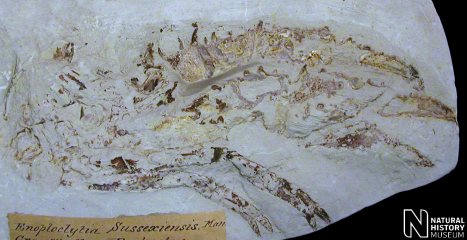 A A |
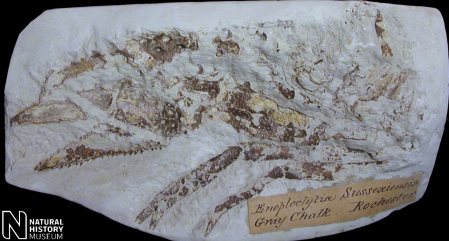 B B |
19). (A, B) Part and counterpart of a well preserved individual split through the middle (x0.8, Grey Chalk, Rochester, Kent, (A) BMNH (British Museum (Natural History) London) 44295, (B) BMNH 44296). Images © 2008 The Natural History Museum, by kind permission.
 A A |
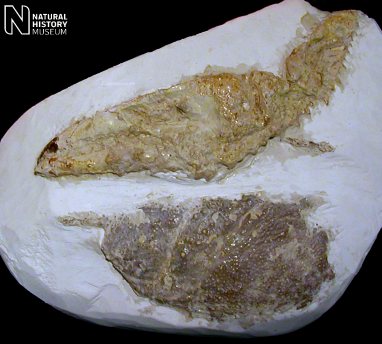 B B |
20). Remains of relatively large individuals: (A) Right lateral view, partial carapace and pair of chelipeds (x0.6, Grey Chalk, Kent, BMNH (British Museum (Natural History) London) 35124); (B) Complete left lateral flank of carapace and cheliped (0.7, Grey Chalk, BMNH 59668). Images © 2008 The Natural History Museum, by kind permission
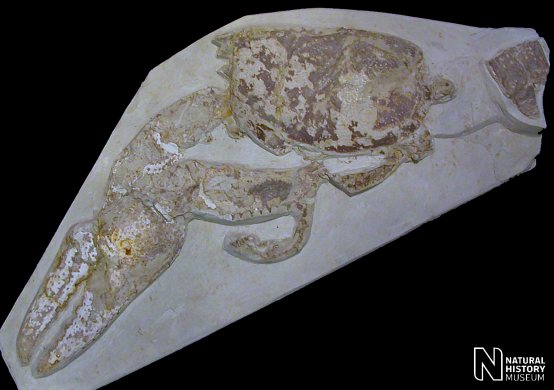
21). Left lateral view of a large individual (x0.5, Grey Chalk, Lewes, Sussex, BMNH (British Museum (Natural History) London) 59824). Image © 2008 The Natural History Museum, by kind permission.

22). Partially disarticulated remains of relatively large individual: complete carapace, near complete abdomen, partial cheliped (x0.9, Grey Chalk, Sussex, Coombes Collection, BMNH (British Museum (Natural History) London) I.2190). Image © 2008 The Natural History Museum, by kind permission.
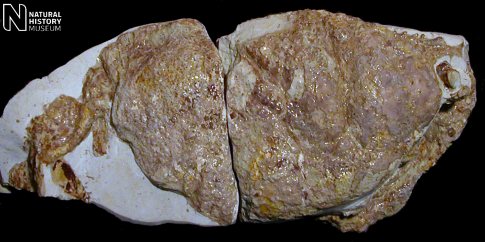 A A |
 B B |
23). Large carapace with eye (Grey Chalk, Cowslip Pit, Guilford, Surrey, Capron Collection, BMNH (British Museum (Natural History) London) 59825): (A) Overview of specimen, x1.4; (B) Detail of eye, x2.5. Images © 2008 The Natural History Museum, by kind permission.
 A A |
 B B |
24). (A) Cheliped of a juvenile (x3.0, White Chalk (Turonian?), Davis' Pit, Guilford, Surrey, Capron Collection, BMNH (British Museum (Natural History) London) 59825). (B) Dorsal view of the anterior portion of the carapace and attached cheliped, figured by Dixon (x1.1, Sussex, BMNH In.36768. Images © 2008 The Natural History Museum, by kind permission.
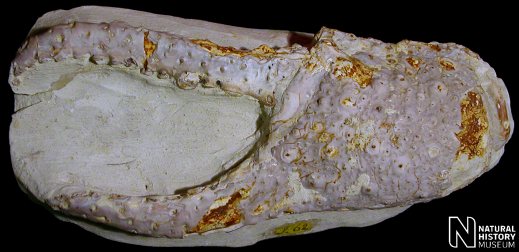
25). Very large cheliped - form approaching that of Enoploclytia (x1.0, White Chalk (Turonian?), Burham, Kent, BMNH (British Museum (Natural History) London) I.62). Image © 2008 The Natural History Museum, by kind permission.
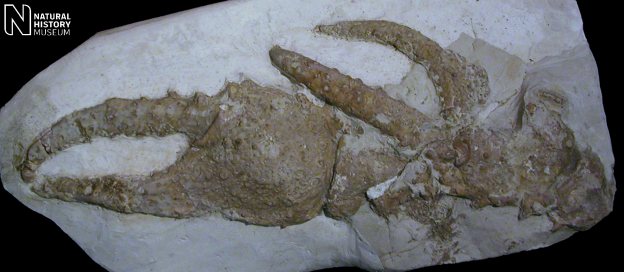
26). Pair of very large chelipeds (x0.7, Grey Chalk, Southern England, BMNH (British Museum (Natural History) London) I.878). Image © 2008 The Natural History Museum, by kind permission.
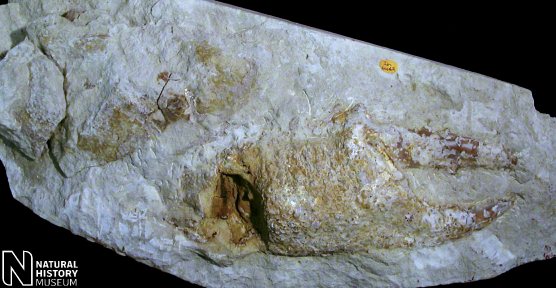
27). Carapace(?) and left cheliped of a very large individual (x0.5, Grey Chalk, Southern England, BMNH (British Museum (Natural History) London) In.60462). Image © 2008 The Natural History Museum, by kind permission.

28). Chelipeds and other elements of a very large individual - part and counterpart (0.5, Grey Chalk, Halling, Kent, BMNH (British Museum (Natural History) London) 46782). Image © 2008 The Natural History Museum, by kind permission.
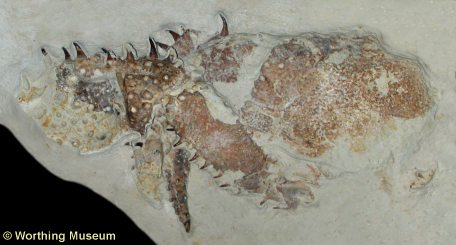 A A |
 B B |
29). (A) Carapace and chelipeds (x1.5, Grey Chalk, Sussex (?), Worthing Museum, Martin Collection, WM 66/323, by kind permission of Worthing Borough Council). (B) Cheliped from an unusually spiny individual (x1.3, Grey Chalk, Booth Museum, BMB 024318, by kind permission of John Cooper).
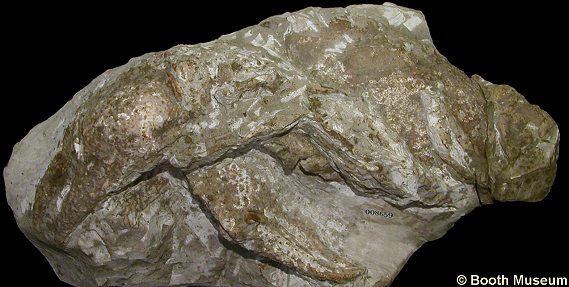 |
30). A very intact and well preserved specimen, needing much preparation work (x0.8, Grey Chalk, In the collections of the Booth Museum, BMB 008659, by kind permission of John Cooper).

31). A well articulated specimen exposed in dorsal view (x0.7, Kent?, in the collections of Maidstone Museum, by kind permission of Ed Jarzembowski).
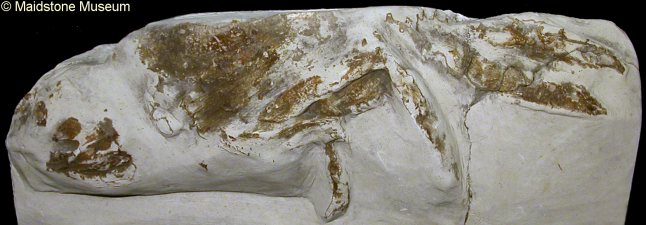
32). Remains of specimen which was preserved essentially intact (x0.9, Kent?, in the collections of Maidstone Museum, MM 221-071, by kind permission of Ed Jarzembowski).
33). An incomplete pair of claws, prepared by reversal technique (x1.3, Grey Chalk, Dover, Kent, Joe Shimmin Collection). Image © 2012 Joe Shimmin, by kind permission.

34). Typical isolated cheliped (x1.5, Bopeep pit, Alciston, East Sussex, Roy Strevens collection, image used by kind permission).